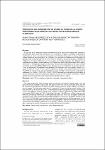Predicción del rendimiento en grano de trigo en la región subhúmedaseca pampeana en base a diferentes índices climáticos
Wheat grain yield prediction in the subhumid dry pampean region based on different weather indices
| dc.contributor.author | Fernández, Miguel Angel | |
| dc.date.accessioned | 2020-11-03T00:25:56Z | |
| dc.date.available | 2020-11-03T00:25:56Z | |
| dc.date.issued | 2019 | |
| dc.identifier.uri | https://repo.unlpam.edu.ar/handle/unlpam/6611 | |
| dc.description.abstract | El trigo pan es el cultivo de invierno más importante en la región subhúmeda seca pampeana, pero presenta gran variabilidad interanual en el rendimiento en grano. El objetivo fue predecir el rendimiento en grano y la respuesta al agregado de fertilizante nitrogenado, en base a diferentes índices climáticos del otoño previo a la siembra. Los ensayos se realizaron en la Facultad de Agronomía de la UNLPam (36º 32’ 49” S, 64º18’20”W) durante un período de 22 años. Al tratamiento fertilizado se le agregó 100 kg.ha1 de urea al voleo en macollaje temprano. Se utilizaron para la predicción los siguientes índices climáticos: ONI (Ocean Niño Index), MEI (Multivariate ENSO Index), TSM Zona 6.1 (Temperatura Superficial del Mar) y TSA (Tropical South Atlantic). No hubo una clara asociación de los índices MEI y ONI durante el otoño previo con el rendimiento en grano de trigo pan, ni con la respuesta a la fertilización con nitrógeno. Sin embargo, hubo una relación inversa (y = 2320x + 50507; R² = 0,25; P=0,017) entre el índice TSM Zona 6.1 del Océano Atlántico (5º y 25ºS; 0º y 20ºW) del mes de marzo con el rendimiento en grano y también con la respuesta al agregado de fertilizante (y = 769,4x + 16117; R² = 0,24; P = 0,02). Esto podría incorporarse en los modelos de decisión previos al inicio de la campaña de trigo para estimar los rendimientos alcanzables y mejorar además los modelos de respuesta a la fertilización nitrogenada en la región. | |
| dc.description.abstract | The bread wheat is the most important winter crop in the subhumid dry Pampa region, but it has great interannual variability in grain yield. The objective this work was to predict the grain yield and the response to the aggregate of nitrogen fertilizer, based on different climate indices in the autumn prior to sowing. The trials were performed for a period of 22 years in the Agronomy Faculty of the UNLPam (36º 32' 49" S; 64º 18' 20" W). The fertilized treatment was added 100 kg.ha1 of broadcast urea in early tillering. Climatic indexes were used for prediction; ONI (Ocean Child index), MEI (multivariate ENSO index) and TSA (Tropical South Atlantic). The MEI index of MarchApril and the ONI index of FebruaryMarchApril did not explain the grain yield. There was a negative relationship between the SST index (sea surface temperature) of March in zone 6.1 of the Atlantic Ocean (5º and 25º S, 0º and 20º W) with the grain yield and also with the response to the fertilizer aggregate. As the index increased, the grain yield and response to the aggregate of fertilizer decreased. This could be incorporated in the decision models prior of the sowing of wheat to estimate the achievable yields and also to improve the models of response to nitrogen fertilization in the region. | |
| dc.format.extent | p. 61-72 | |
| dc.format.medium | application/pdf | |
| dc.language.iso | spa | |
| dc.rights | Atribución-NoComercial-CompartirIgual 2.5 Argentina (CC BY-NC-SA 2.5 AR) | |
| dc.rights.uri | https://creativecommons.org/licenses/by-nc-sa/2.5/ar/ | |
| dc.source.uri | https://repo.unlpam.edu.ar/handle/unlpam/5690 | |
| dc.title | Predicción del rendimiento en grano de trigo en la región subhúmedaseca pampeana en base a diferentes índices climáticos | |
| dc.title | Wheat grain yield prediction in the subhumid dry pampean region based on different weather indices | |
| dc.type | artículo | |
| dc.unlpam.doi | http://dx.doi.org/10.19137/semiarida.2019(02).61-72 | |
| dc.unlpam.instituciondeorigen | Facultad de Agronomía | |
| dc.unlpam.seccion | Artículos Científicos y Técnicos | |
| dc.unlpam.access | openAccess | |
| dc.unlpam.version | acceptedVersion | |
| dc.unlpam.filiacion | Fernández, Miguel Angel. Universidad Nacional de La Pampa, Facultad de Agronomía, La Pampa, Argentina | |
| dc.subject.keyword | Triticum aestivum | |
| dc.subject.keyword | prediction | |
| dc.subject.keyword | yield | |
| dc.subject.keyword | nitrogen response | |
| dc.subject.palabraclave | Triticum aestivum | |
| dc.subject.palabraclave | predicción | |
| dc.subject.palabraclave | rendimiento | |
| dc.subject.palabraclave | respuesta nitrógeno | |
| dc.source.revistaunlpam | Semiárida: Revista de la Facultad de Agronomía. 2019; vol.29 no.2 |
Files in this item
This item appears in the following Collection(s)
-
Semiárida : revista de la Facultad de Agronomía [816]
Revista científica semestral de la Facultad de Agronomía, UNLPam.











